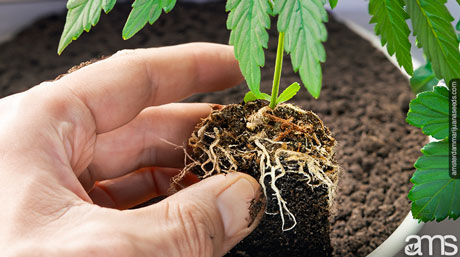Table of Contents
Growing marijuana can be challenging, but growing it in rocky soil can be even more daunting. Rocky soil lacks the essential nutrients necessary for plant growth, and the rocks can prevent or hinder root development.

Despite these challenges, growing marijuana in rocky soil is possible with a few essential tips and tricks. This article outlines how to grow healthy, robust marijuana plants in rocky soil to ensure a successful harvest. Read on to learn all these tips and tricks for growing marijuana in rocky soil!
Feminized cannabis, as the name suggests, refers to cannabis plants that are genetically engineered to produce only female plants. The advantage of using feminized cannabis seeds is that they yield female plants almost exclusively, eliminating the need to identify and remove male plants.
This efficiency can significantly increase your yield, as every plant you’re nurturing is bud-producing. However, feminized seeds can be more expensive and may not be as resilient to environmental stress as regular seeds. They also limit natural genetic variation, which could be a downside if you enjoy experimenting with your crop.
Understanding the benefits of using rocky soil for planting marijuana is essential to ensure optimal plant growth. Here are some of the benefits you can get when you opt to use rocky soil for your marijuana plants:
Unlike other soil types, rocky soil can benefit you by having excellent water drainage. Proper drainage is one of the many factors that affect your plant’s growth and development. When compared with other soil types like clay soil, rocky soil is much preferred as it does not hold water, lowering the chances of waterlogged, rotted roots, and other issues caused by poor drainage in your potting medium.
Temperature fluctuations can harm plant growth significantly when the soil temperature fluctuates rapidly. However, using rocky soil can help prevent sudden changes in soil temperature as the rocks act as insulators. This helps regulate the soil’s temperature, keeping it stable and within the optimal range for marijuana plant growth.
In addition, stable soil temperature can help promote healthy root development, vital for nutrient absorption and overall plant health. That is why rocky soil benefits marijuana plants in receiving the right temperature for optimal growth and development.
Pests such as grubs, worms, and mole rats can burrow through the soil and damage the plant roots, leading to stunted growth, disease, or plant death. Rocky soil, however, reduces the risk of pest damage as the rocks act as a natural barrier that discourages pests from digging into the soil.
The rocks create an inhospitable environment for pests, making it harder for them to survive and propagate. As a result, using rocky soil minimizes the risk of losing the marijuana plant to pest damage, leading to healthy and thriving plants.
Using rocky soil in growing marijuana plants reduces weeding because rocky soil often has a more challenging environment for weeds. Weeds need loose and fertile soil to grow, and rocky soil needs to meet these requirements. The rocks in the soil prevent weed seeds from finding the necessary space and nutrients to germinate and grow.
Additionally, using a weed barrier fabric or wood chips in rocky soil creates an extra barrier that can further reduce weed growth. By reducing weed growth, cannabis growers can save time and energy that would otherwise be spent removing weeds. This saved time can be redirected toward other essential plant care practices, ultimately leading to optimal plant growth and health.
Unlike other soil types, rocky soil offers a stable base for your marijuana plants to grow in. This allows your plant to develop and spread its roots wider, leading to better control over its growth. Moreover, the rocky soil type adds benefits to your marijuana plants through great stabilization, preventing them from getting easily uprooted by wind or harsh weather conditions.
Another benefit of using rocky soil in growing your marijuana plants is that this type of soil is less likely to develop soil erosion in the future. This is because rocky soil contains pebbles and stones that help hold the soil together, preventing it from getting washed away when harsh weathers happen. This is especially true for marijuana plants growing outdoors.
If you’re planning to grow marijuana in rocky soil, here are some tips to help you get started:
The first thing you need to know when growing marijuana in rocky soil conditions is to identify the suitable strains in this soil type. Here are some recommended marijuana strains for rocky soil types:
When growing cannabis in rocky soil, choosing hardy, tolerant strains that can handle soil fluctuations is essential. The strains listed above are known for their adaptability to rocky soil conditions and can produce a quality yield with proper care and attention.
It is no secret that growing cannabis in rocky soil conditions can be quite a challenge. Not only do rocky soils lack the essential nutrients that cannabis plants need, but they also drain quickly, resulting in water loss and reduced nutrient absorption.
With that in mind, increasing control over soil quality and drainage should be your top priority. Raising raised beds for growing marijuana plants helps keep rocks and pebbles from directly touching plant roots.
Another helpful tip in maintaining optimum health for marijuana plants growing in rocky soil is to install barriers that help your plant’s roots penetrate deeper into the soil. As rocky soil is known to contain pebbles, stones, and rocks that may prevent the spread of your plant’s roots, building a barrier greatly helps in ensuring that their growth is not obstructed.
Rocky soil typically drains faster than other soils, meaning water is not held in place, and moisture retention can be challenging. Water also tends to run off rocky soil, removing nutrients from the roots and preventing absorption. That is why it is essential to water marijuana plants growing in rocky soil carefully.
Monitoring marijuana plants growing in rocky soil conditions is essential for successful growth and bountiful yields. Regular inspections help identify and address issues, such as nutrient deficiencies, pest infestations, or soil pH imbalances, before they worsen and affect the plants’ health.
Maintaining a healthy marijuana plant involves several factors, including providing the right environment, proper feeding and watering, and constant monitoring. Here are some tips for maintaining a healthy marijuana plant:
One of the most crucial things many cannabis growers overlook, especially beginners, is the growing environment. Although it is the most basic, many mistook this part as an essential thing to consider. Setting the right environment includes preparing proper soil pH, lighting, temperature, and air circulation.
Growing marijuana plants require you to understand various strands and their unique demands. Some strains have specific needs, but generally, these plants prefer slightly acidic soil with a pH range of 6.0-6.5. Soil pH levels outside this range can result in stunted growth, nutrient deficiencies or toxicities, and other health issues.
In addition to soil pH levels, sun exposure and air circulation for marijuana plants grown indoors are equally important. Depending on their strains, most cannabis plants require 12 hours of sunlight daily to grow correctly. They also need good air circulation to prevent the growth of fungi, mold, and other diseases that thrive in humid conditions.
When you are growing marijuana in rocky soil, it is essential to monitor their daily conditions. This is to save you from possible future issues such as:
Another tip is to fully support your plant, especially when you grow it in rocky soil conditions. This gesture will also guarantee the maximum yield. Although providing support helps increase the yield, proper care and strain type also contribute to this aspect. Here are some of the popular cannabis strains that will offer you high yields:
When growing marijuana plants in rocky soil conditions, making sure that you prune them helps maximize their yield and health. Pruning is a technique that involves removing specific parts of the plant, like branches, buds, and leaves. This pruning technique can be particularly beneficial to cannabis plants grown in rocky soil conditions for the following reasons:
Sativa strains originate from equatorial regions and are generally tall and skinny plants with narrow leaves, and they require ample light to grow well. Sativa strains tend to provide consumers with an “uplifting” and “energetic” high, making them perfect for daytime use. Some common Sativa strains include:
Indica strains have their origin in central Asia and the Indian subcontinent. They are shorter and often bushier plants with broad leaves, and they thrive in cooler temperatures. If you are wondering the differences between Sativa and Indica strains, you may want to go deeper into the details of their features, characteristics, and attributes.
Indica strains provide consumers with a calming and relaxing body high, perfect for nighttime use. Here are some common Indica strains:
Another tip to ensure your marijuana plant grows in its optimal health is to provide proper ventilation. Whether growing your marijuana indoors or outdoors, adequate ventilation is imperative in maintaining your plant’s health.
For indoor growing, marijuana plants require proper ventilation to better manage temperature, humidity levels, carbon dioxide levels, and odor control, as marijuana plants are known for having a strong and pungent smell, especially when they start flowering. Proper ventilation helps you control the smell, significantly if you are growing them indoors.
Growing marijuana in rocky soil can be challenging, but it is achievable with the right tips and tricks. Adequate soil preparation, watering, monitoring soil nutrients, and employing companion planting techniques are ways to optimize plant growth in rocky soil.
By following these guidelines, gardeners will find themselves well on their way to a successful marijuana harvest. With patience and persistence, growing marijuana in rocky soil can produce healthy plants and a bountiful harvest.













Related Posts

You’ve probably heard of the two most popular ways to grow cannabis plants: hydro and soil. But which one is right for you? In this article, we’ll take a look at the pros and cons of each method so you can make an informed decision.

Introduction:
Cannabis cultivation has gained considerable attention in recent years, thanks to its increasing legalization and therapeutic potential. While many growers focus on lighting, nutrients, and watering techniques, the significance of the root system is often overlooked. The root system plays a crucial role in supporting the plant’s overall health, growth, and nutrient absorption. In this article, we will explore…